The Godfather (1972) Is The greatest movie of all time
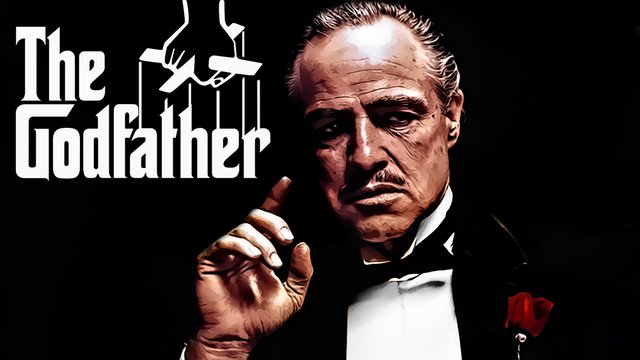
“The Godfather” is told entirely within a closed world. That’s why we sympathize with characters who are essentially evil. The story by Mario Puzo and Francis Ford Coppola is a brilliant conjuring act, inviting us to consider the Mafia entirely on its own terms. Don Vito Corleone (Marlon Brando) emerges as a sympathetic and even admirable character; during the entire film, this lifelong professional criminal does nothing of which we can really disapprove.
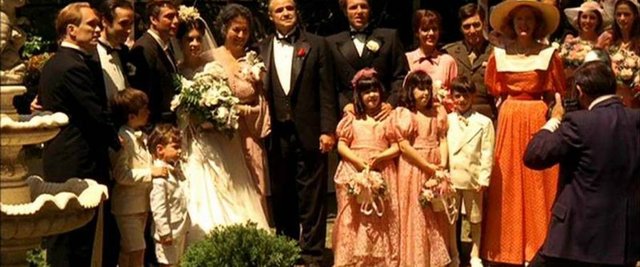
During the movie we see not a single actual civilian victim of organized crime. No women trapped into prostitution. No lives wrecked by gambling. No victims of theft, fraud or protection rackets. The only police officer with a significant speaking role is corrupt.
The story views the Mafia from the inside. That is its secret, its charm, its spell; in a way, it has shaped the public perception of the Mafia ever since. The real world is replaced by an authoritarian patriarchy where power and justice flow from the Godfather, and the only villains are traitors. There is one commandment, spoken by Michael (Al Pacino): “Don’t ever take sides against the family.”
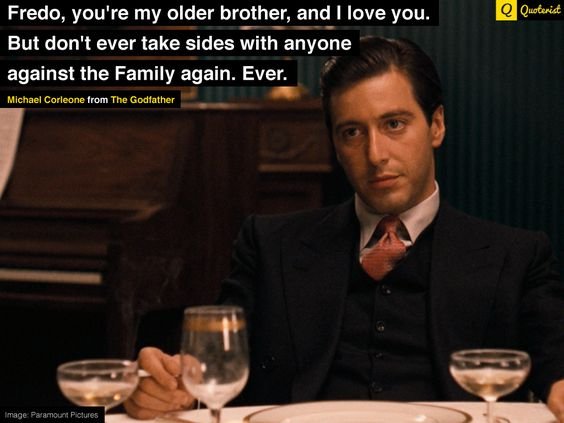
It is significant that the first shot is inside a dark, shuttered room. It is the wedding day of Vito Corleone’s daughter, and on such a day a Sicilian must grant any reasonable request. A man has come to ask for punishment for his daughter’s rapist. Don Vito asks why he did not come to him immediately.
“I went to the police, like a good American,” the man says. The Godfather’s reply will underpin the entire movie: “Why did you go to the police? Why didn’t you come to me first? What have I ever done to make you treat me so disrespectfully? If you’d come to me in friendship, then this scum that ruined your daughter would be suffering this very day. And if, by chance, an honest man like yourself should make enemies . . . then they would become my enemies. And then they would fear you.”

As the day continues, there are two more scenes in the Godfather’s darkened study, intercut with scenes from the wedding outside. By the end of the wedding sequence, most of the main characters will have been introduced, and we will know essential things about their personalities. It is a virtuoso stretch of filmmaking: Coppola brings his large cast onstage so artfully that we are drawn at once into the Godfather’s world.
The screenplay of “The Godfather” follows no formulas except for the classic structure in which power passes between the generations. The writing is subtly constructed to set up events later in the film. Notice how the request by Johnny Fontane, the failing singer, pays off in the Hollywood scenes; how his tears set up the shocking moment when a mogul wakes up in bed with what is left of his racehorse. Notice how the undertaker is told “someday, and that day may never come, I will ask a favor of you. . .” and how when the day comes the favor is not violence (as in a conventional movie) but Don Vito’s desire to spare his wife the sight of their son’s maimed body. And notice how a woman’s “mistaken” phone call sets up the trap in which Sonny (James Caan) is murdered: It’s done so neatly that you have to think back through the events to figure it out.
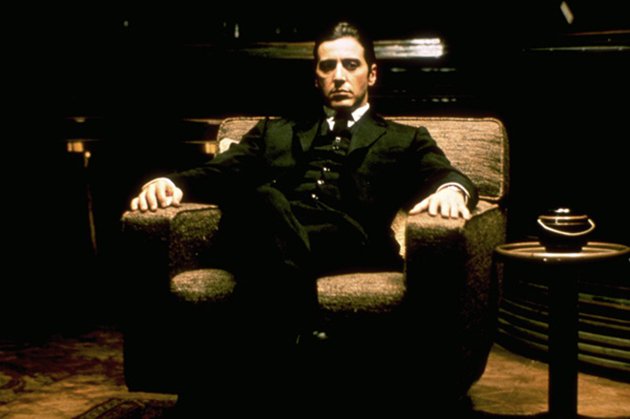
Now here is a trivia question: What is the name of Vito’s wife? She exists in the movie as an insignificant shadow, a plump Sicilian grandmother who poses with her husband in wedding pictures but plays no role in the events that take place in his study. There is little room for women in “The Godfather.” Sonny uses and discards them, and ignores his wife. Connie (Talia Shire), the Don’s daughter, is so disregarded that her husband is not allowed into the family business. He is thrown a bone--”a living”--and later, when he is killed, Michael coldly lies to his sister about what happened.
The irony of the title is that it eventually comes to refer to the son, not the father. As the film opens Michael is not part of the family business, and plans to marry a WASP, Kay Adams (Diane Keaton). His turning point comes when he saves his father’s life by moving his hospital bed, and whispers to the unconscious man: “I’m with you now.”
After he shoots the corrupt cop, Michael hides in Sicily, where he falls in love with and marries Appolonia (Simonetta Stefanelli). They do not speak the same language; small handicap for a Mafia wife. He undoubtedly loves Appolonia, as he loved Kay, but what is he thinking here: that he can no longer marry Kay because he has chosen a Mafia life? After Appolonia’s death and his return to America, he seeks out Kay and eventually they marry. Did he tell her about Appolonia? Such details are unimportant to the story.
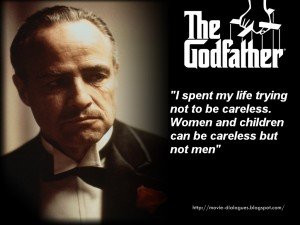
What is important is loyalty to the family. Much is said in the movie about trusting a man’s word, but honesty is nothing compared to loyalty. Michael doesn’t even trust Tom Hagen (Robert Duvall) with the secret that he plans to murder the heads of the other families. The famous “baptism massacre” is tough, virtuoso filmmaking: The baptism provides him with an airtight alibi, and he becomes a godfather in both senses at the same time.
Vito Corleone is the moral center of the film. He is old, wise and opposed to dealing in drugs. He understands that society is not alarmed by “liquor, gambling . . . even women.” But drugs are a dirty business to Don Vito, and one of the movie’s best scenes is the Mafia summit at which he argues his point. The implication is that in the godfather’s world there would be no drugs, only “victimless crimes,” and justice would be dispatched evenly and swiftly.
My argument is taking this form because I want to point out how cleverly Coppola structures his film to create sympathy for his heroes. The Mafia is not a benevolent and protective organization, and the Corleone family is only marginally better than the others. Yet when the old man falls dead among his tomato plants, we feel that a giant has passed.
Gordon Willis’ cinematography is celebrated for its darkness; it is rich, atmospheric, expressive. You cannot appreciate this on television because the picture is artificially brightened. Coppola populates his dark interior spaces with remarkable faces. The front-line actors--Brando, Pacino, Caan, Duvall--are attractive in one way or another, but those who play their associates are chosen for their fleshy, thickly lined faces--for huge jaws and deeply set eyes. Look at Abe Vigoda as Tessio, the fearsome enforcer. The first time we see him, he’s dancing with a child at the wedding, her satin pumps balanced on his shoes. The sun shines that day, but never again: He is developed as a hulking presence who implies the possibility of violent revenge. Only at the end is he brightly lit again, to make him look vulnerable as he begs for his life.

The Brando performance is justly famous and often imitated. We know all about his puffy cheeks, and his use of props like the kitten in the opening scene. Those are actor’s devices. Brando uses them but does not depend on them: He embodies the character so convincingly that at the end, when he warns his son two or three times that “the man who comes to you to set up a meeting--that’s the traitor,” we are not thinking of acting at all. We are thinking that the Don is growing old and repeating himself, but we are also thinking that he is probably absolutely right.
Pacino plays Michael close to his vest; he has learned from his father never to talk in front of outsiders, never to trust anyone unnecessarily, to take advice but keep his own counsel. All of the other roles are so successfully filled that a strange thing happened as I watched this restored 1997 version: Familiar as I am with Robert Duvall, when he first appeared on the screen I found myself thinking, “There’s Tom Hagen.”
Coppola went to Italy to find Nino Rota, composer of many Fellini films, to score the picture. Hearing the sadness and nostalgia of the movie’s main theme, I realized what the music was telling us: Things would have turned out better if we had only listened to the Godfather.
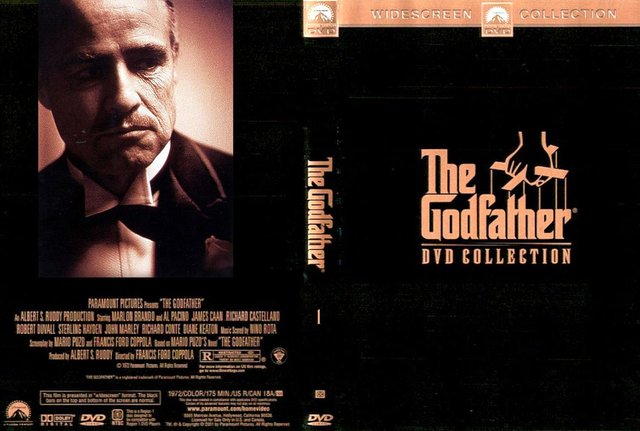
and my favorite speak of Don Vito Corleone :
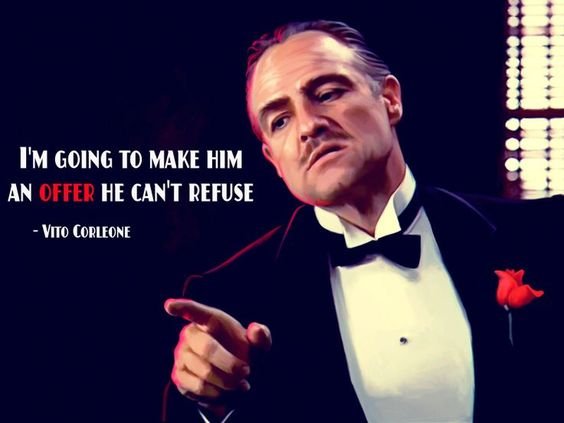
THANKS TO MARIO PUZO :-)
to long stroies
wow i love this movie ...old movie but incredible